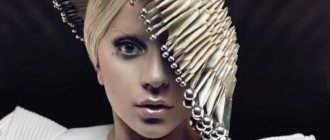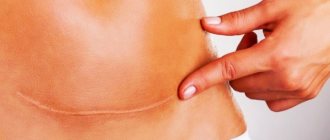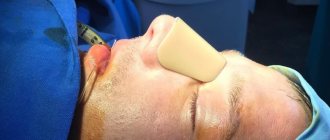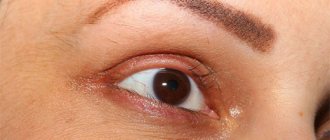Medically known as medial or lateral epicanthoplasty, epicanthoplasty is a type of blepharoplasty that aims to lengthen the inner parts of the eye to make it larger and eliminate the fold of skin located on the upper eyelid.
This cosmetic procedure is more often performed in Asian countries.
In demand among men and women. After the manipulation, the eyes look wide open, the bridge of the nose visually narrows.
Epicanthus
The epicanthus or Mongolian fold is a semilunar fold of skin on the medial canthus. This condition does not cause any symptoms and is a cosmetic defect.
It is observed in representatives of the Australo-Negroid and Mongoloid races. For Europeans - atypical.
Possible darkening of the visual axis, associated ptosis, strabismus.
Scientists believe that in people of the Mongoloid race it appears as a protective apparatus for the organs of vision from specific climatic conditions. The development of epicanthus leads to:
- ptosis;
- avulsion of the medial canthus after injury;
- Down syndrome.
What is picanthus in a child?
There are several versions of the manifestation of epicanthus in an adult, according to one of which such a fold is designed to provide protection to the lacrimal canaliculi from dust, injuries and the effects of external temperatures.
For your information! In children, the epicanthus is often perceived as a non-pathological formation, which is only a sign of visual organs that are not fully formed, but only if the fold disappears by preschool age.
Also, epicanthus is sometimes recognized as a harmless formation that occurs against the background of an enlarged and flat bridge of the nose.
In what cases can epicanthoplasty be performed?
Epicanthoplasty is a cosmetic manipulation; every patient who has no contraindications is allowed to use it . Most patients are of Asian descent, but the surgery is performed for cosmetic defects in one eye.
It is an ideal procedure for male or female patients with the following indications:
- severe drooping of the eyelids caused by skin folds;
- large amount of fat in the upper eyelid area;
- tissue ptosis;
- narrow shape
- congenital anomaly.
Indications for implementation are external reasons. It is performed if the Mongolian fold occurs due to the formation of scars after injury.
Diagnostics
To determine epicanthus in children there is no need to perform special diagnostic procedures . The specialist determines the presence of a fold exclusively visually .
Know! Additionally, the child’s medical history, starting from birth, can be studied: in some cases, the cause of the appearance of such a formation can be identified by reading the medical history.
also possible to trace Asian roots in the patient's pedigree : in this case, the pathological etiology of the disease is extremely unlikely.
Types of epicanthoplasty
This operation is performed to completely remove the fold. It can be performed independently or together with double eyelid surgery to obtain better results.
There are several types:
- Medial . The epicanthus is cut out and a new fold is formed. Lasts 30 minutes, hospitalization is not required, recovery period is 7 days, local anesthesia with sedation. Sutures are removed 5 days after epicanthoplasty.
- Lateral . The manipulation changes the shape of the outer corners of the eyes. They will appear large and open. The shape of the lateral epicanthus changes, the corner lengthens by 3–5 mm. The duration of the procedure is 30 minutes, after which the patient remains in the hospital or goes home. Recovery takes 1 week. Lateral epicanthoplasty is performed under local anesthesia. The stitches are removed after a week.
- Lateral + drooping corners of the eyes . The procedure changes the shape of the outer corner while simultaneously tilting it. The eye lengthens by 4-5 mm, hospitalization is not required, the recovery period is 1 week.
There are two more methods. The suture method is used if there is a double fold of skin on the upper movable integument above the eye . It is dissected from the inside, sutures are placed between the muscle that is responsible for raising the eyelid and the dermis. This is done to deepen the double fold; the fold itself is not removed.
The seamless method involves weakening the internal structures of the fold, reducing its tension . The fat layer will gradually be distributed throughout the upper eyelid.
Methods of surgical intervention
Figure 5. Lateral canthoplasty with division of the inferior lateral canthal ligament.
Figure 6. Lateral canthoplasty with division of the superior and inferior lateral canthal ligament.
Depending on the task, doctors can perform the operation in combination with various manipulations. There are three main approaches, each of which can be combined with blepharoplasty for significant rejuvenation. 1. Lateral. The ligament is cut, lifted and secured. It is sutured to the periosteum or immediately to the edge of the bone of the orbital zone. The method is suitable for changing the shape or shape of the eyes. All manipulations take place through an incision not up to 1 cm long. Access in the natural crease of the eyelid and the surgeon’s experience make the scar invisible. Only a professional can recognize the operation performed; for others, the reason for the sudden transformation will remain a mystery.
Figure 7. Canthoplasty with eyelid shortening and cartilage modeling.
2. Surgery to change the shape of the cartilage. The result is not only a lifting of the corner of the eye, but also a reduction in the size of the lower eyelid. Necessary for sagging eyelids, which makes the face look tired.
Figure 8. Cantomyoplasty with cutting out a muscle flap.
3. Cantomyopexy. The doctor cuts out part of the orbicularis muscle, securing the resulting flap to the tendon plate of the temporalis fascia.
Reviews about canthoplasty
“Many thanks to the plastic surgeon I.S. Kochneva.
and her entire team. These are true professionals who not only do their job efficiently, but are also very attentive to their patients. My 57-year-old mother came to the clinic. She underwent blepharoplasty, SMAS-plasty (this is a tightening of the skin of the neck and lower part of the face). Then resection of the DAO was performed and facial lipofilling was performed. Mom has always been a beautiful, impressive woman, but age has given her face a tired look. Ilona Sergeevna and her team were able to fix this. At the same time, my mother remained herself, her facial features did not change, she simply became young and beautiful again. Now the address “grandmother” does not really suit her - she is a beautiful, well-groomed woman with an open look. Natalya, 57 years old.” Read other patient reviews about canthoplasty performed by surgeons at the Abrielle Clinic. Select the operation you are interested in in the catalog and see what patients think about the doctors, the service and the results of the operation.
Preparing for surgery
To get rid of epicanthus, consult a plastic surgeon, ophthalmologist and cosmetologist. Doctors must confirm the possibility of removing a cosmetic defect.
Preparation for epicanthoplasty includes:
- refusal of blood thinning medications 3-5 days before removal of a cosmetic defect;
- taking blood tests;
- Inspection of paranasal structures.
When examining the eyes, a plastic surgeon evaluates the thickness, condition of the skin, volume of fat, the presence of previous surgical interventions on the eyes, and the patient’s age.
To obtain approval for epicanthoplasty, a coagulogram is performed, tests for HIV, hepatitis B and C, syphilis, and an ECG are taken.
The results are sent to a plastic surgeon or therapist. On their basis, permission to perform the operation is given.
Progress of the operation
Europeanization of the eyelids is a popular procedure for people with oriental eye shape and heavily overhanging eyelids. For the operation to be successful, it is important to follow all the doctors’ recommendations.
Progression of epicanthoplasty:
- The plastic surgeon applies preoperative markings according to which the skin fold will be removed.
- The visual organs are treated with an antiseptic solution.
- The patient is given local infiltration anesthesia.
- The cuts are made according to the intended markings. To eliminate a small epicanthus, excision of the upper mobile skin above the eye is sufficient. If the fold is pronounced, plastic surgery of the inner corner is performed.
- Remove excess skin.
- Cosmetic stitches are applied.
Epicanthoplasty is combined with Singapore eyelid plastic surgery.
Complications
When performed by a licensed, experienced surgeon, epicanthoplasty is a safe procedure with high success rates. However, like any surgical procedure, it leads to complications:
- Allergic reaction to anesthetic . Complication is unlikely. Therefore, a skin test should be performed before using the anesthetic.
- Infection . An extremely rare complication. Occurs when incisions become infected with surgical instruments. Treated with antibiotics.
- Poor scarring . Not all patients' skin heals quickly and grows together. Scars may remain visible for several months.
Postoperative complications of epicanthoplasty are very rare. In practice, the procedure is easily performed without any problems.
Useful video
This video presents a review from a patient after Europeanization of her eyes:
Epicanthoplasty is an operation, the successful outcome of which almost entirely depends not on the patient and the characteristics of the epicanthus, but on the skill of the specialist, who must take into account many factors .
For this reason, it is necessary to choose well-known clinics that employ surgeons with extensive practical experience.
And it is not worth saving on the cost of such procedures: almost always the high cost of such operations allows us to guarantee the quality of their implementation.
Rehabilitation
After surgery, the patient experiences minor swelling for 10–15 days after the sutures are removed. The final result will appear no earlier than in a month.
During rehabilitation, follow the instructions of a specialist:
- Keep the wound clean and dry. Wash with clean water, do not use cosmetics, so as not to provoke the development of infection.
- Wear sunglasses for the first week after surgery.
- Avoid drinking a lot of water before bed to avoid eye puffiness.
- Do not smoke, drink alcohol or eat spicy foods to speed up wound healing.
- For 3 days, use antibacterial drops and apply cold compresses to the eyelids.
- CL should not be worn for 14 days.
After 1 month, you need to see a surgeon. He will tell you when you can use cosmetics and exercise.
After surgery, it is recommended to undergo a course of rehabilitation physiotherapeutic procedures (microcurrents). They help reduce swelling and bruises will disappear faster.
Possible complications
Injection blepharoplasty has the lowest risk of serious complications. This procedure may only cause temporary redness and slight swelling, which will subside within 24-72 hours.
Transcutaneous (traditional) blepharoplasty due to the use of surgical intervention is a more difficult process. Final recovery takes place within 6 months, and in some difficult situations, final healing occurs a year after surgery.
Early side effects that usually go away within 3 weeks include:
- Swelling under the eyes.
- Bruises, itching and hematomas.
- Blurring and periodic doubling of objects in the field of vision. If these symptoms do not go away within 3 weeks, you should urgently consult an ophthalmologist.
- Thinning of eyelashes, which goes away quickly.
- Periodic headaches are possible.
All of the above manifestations are considered normal and should resolve on their own within 20 days. If complications occur over a longer period, you must contact a surgeon or ophthalmologist.
There are complications that arise in the later period after lower eyelid blepharoplasty. These include:
- the appearance of cysts along the suture lines (dissolve on their own or are easily removed);
- divergence of seams (the condition requires reapplication of new ones);
- tearfulness;
- possible preservation of hernia remnants.
Also in practice, there are a number of medical errors, the commission of which has the following consequences:
- the occurrence of ectropion (inversion of the eyelid);
- normal eye shape;
- the appearance of the effect of “short” eyelids – accompanied by insufficient closure;
- asymmetry as a result of poor-quality suturing or improper scarring.
To obtain a high-quality effect and the absence of serious complications after blepharoplasty, it is necessary to take a responsible approach to the choice of a medical institution and a doctor.
Contraindications
The operation is not allowed for all people. There are contraindications to epicanthoplasty:
- poor blood clotting;
- severe somatic pathologies;
- increased IOP;
- hepatitis;
- venereal pathologies;
- diabetes mellitus and other endocrine diseases;
- acute infectious diseases;
- malignant eye formations;
- inflammation of the mucous membrane of an acute or chronic nature.
After treatment of inflammatory and infectious diseases, surgery can be performed. But first they undergo repeated diagnostics to make sure there are no diseases.
It is contraindicated to administer anesthesia to pregnant women, patients with mental disorders and severe chronic diseases.
Causes
Note! In addition to protection from various external influences and irritants, epicanthus can indicate possible diseases:
- chromosomal pathologies that appeared at the stage of intrauterine development;
- diseases of the endocrine system;
- severe toxicosis that the mother had during pregnancy;
- protracted and difficult labor;
- drinking alcohol and smoking during pregnancy;
- prematurity or multiple pregnancy;
- infection of the fetus and any intrauterine abnormalities.











